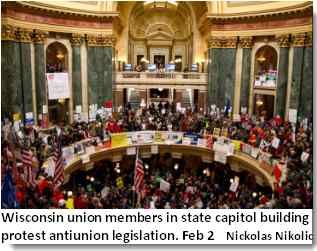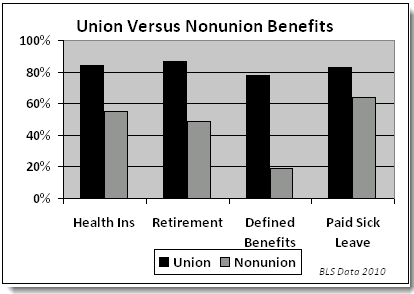Man wouldn't pay you unless he had to. Chris Rock
The antiunion movement in the United States keeps us underpaid and
represents a serious impediment to economic growth. Despite that, the
antiunion sentiment remains strong among the political establishment and
their patrons. Why?
Worker rights and a decent wage represent a toxic brew to the ruling
elite. In the past, they expressed their antiunion position in a crude
fashion. From the 1870s through the 1920s, industrialists fought
union growth with hired thugs and complicit law enforcement officials.
Organizers and union members were harassed, maimed, and killed throughout the country for simply acting on the right to organize and participate in a union.
![]()
When union power and public decency prevailed, the elite shifted their efforts. The right to work
movement emerged. Restrictive laws making it harder to organize unions
became the main thread of crony capitalist efforts. Antiunion
propaganda ran parallel to this backroom strategy. The image of the
lazy worker and corrupt union boss became a mantra of right wing
puppets. When unions did succeed, the elite offered union leaders the
benefits of insider status in order to moderate their positions.
The tactics varied around the world, but the strategy remained the same: reduce the size an influence of unions as a means of keeping wages low and profits through the roof. The tactics worked.
Only Canada and Korea, in particular, showed growth in union membership since the 1970s. France and the United Kingdom saw substantial losses. Unions contracted at a slower rate in Japan and the United States. The impact was the same, loss of political influence for the union movement.
When the British Labour Party produces a leader like Tony Blair, it is abundantly clear that Labour is a nominal term, not a union label.
Even German unions joined the great decline in political influence and integrity. Membership is down to 23% of the work force. Top union leaders work with management by supporting national legislation to weaken the option to strike.
Union Benefits in the United States
Would you have paid health insurance today without a robust union movement a century ago? Probably not. In addition to health care, unions fought for and gained retirement plans, compensated sick days, and defined benefits plans. Corporations were unable to provide these benefits to union employees while, at the same time, denying them to middle managers and professionals.
There remains a strong causal relationship between unionized firms and decent benefits and wages. Unions confer advantages to nonunion employees as well. Union gains in the graph below form the foundation for a better quality of life.
The benefits listed in the chart demonstrate the source of owner reactivity to union efforts. Meaningful benefits cost money that owners resent delivering to their employees.
Union wages are higher than nonunion. The US Bureau of Labor Statistics just reported that the median weekly income of a union worker is $917 compared to $717 for nonunion workers, a 28% disadvantage.
Despite the obvious advantages, union membership has declined markedly in the United States. There are fewer members today, 14.7 million, than there were in 1983 when 17.7 million workers belonged to unions. Only 11.9% of the workforce belongs to unions. The figure was 20.1% in 1983.
An Antiunion Canard Exposed
The antiunion movement would have us believe that strong unions are incompatible with global competition. A look at the growth in gross domestic product (GDP, see graph below) shows that the nation with the most powerful union movement, the Republic of Korea, had the most consistent growth in GDP since 1996. Was the 239.3% increase in union membership an impediment to that nation's growth in GDP? Even with the onset of the 2008 economic crisis, Korea outpaced the other nations listed.
(Note: You can view every article as one long page if you sign up as an Advocate Member, or higher).







